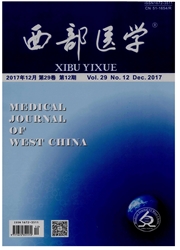

 中文摘要:
中文摘要:
目的钛表面结构及成分会影响钛和骨组织的界面键合,为增强钛表面的生物活性,促进材料与骨组织的键合,本文旨在钛表面构建微纳结构并原位沉积磷酸钙。方法首先,通过碱热处理,在钛表面构建微纳结构。将处理后的钛置于添加环己烷六羧酸(H6L)的钙磷溶液中,进行水热处理。采用SEM,EDX,XRD及FTIR等分析手段对材料进行表征。此外,考察了钛碱热处理与原位沉积磷酸钙钛表面成骨细胞生长情况。结果240℃碱热处理下,钛表面生成平均长度在8μm左右的钛酸钠纳米线。经过二次水热后,磷酸钙颗粒在纳米线上发生原位沉积,而未加入H6L的钙磷溶液中,纳米线上没有发生磷酸钙沉积。这说明,H6L的加入有利于磷酸钙在纳米线上沉积。细胞结果表明,原位沉积磷酸钙的钛表面更有利于细胞增殖。结论本文通过二次水热的方法,成功在钛表面制备出舍磷酸钙/纳米线的多级微纳结构,有望应用于骨植入材料表面改性。
 英文摘要:
英文摘要:
Objective Titanium (Ti) and alloys are widely used in the bone repair due to their good biocompatibility. The bonding between Ti implants and tissues is significantly affected by Ti surface microstructure and composition. Therefore, in order to enhance the biological activity of the titanium surface and promote the bonding of materials and bone tissues, the study was aimed to construct micro/nano-structures on titanium surface and in-situ deposition of calcium phosphate. Methods First, alkali-heat treatment was used to construct microstructures on titanium surface. Then, CaP crystals were deposited on the treated Ti surface from solutions containing eyclohexanehexacarboxylic acid (H6 L) under hydrothermal conditions. Products were characterized by scanning electron microscope equipped with energy disperse spectroscopy, X-ray diffraction and Fourier transform infrared spectroscope spectrometry. In addition, the cell growth on the alkali heat treated Ti surface and calcium phosphate in-situ deposited Ti surface was also investigated. Results Nanowires (mean length: - 8μm) formed on the Ti surface at 240 ℃. After the two-step hydrothermal treatment, calcium phosphate particles are deposited on the titanium nanowire, and calcium phosphate could not deposit on titanium nanowire without H6 L in solution. The results proved that H6L was beneficial for calcium phosphate deposition on the titanium nanowire. Moreover, cell results indicated that Ti surface modified by calcium phosphate in-situ deposition was more favorable for cell proliferation. Conclusion The two step hydrothermal method was successfully used to fabricate hierarchical structure composed of calcium phosphate/nanowire and is expected to be applied to the surface modification of bone implants.
 同期刊论文项目
同期刊论文项目
 同项目期刊论文
同项目期刊论文
 期刊信息
期刊信息
